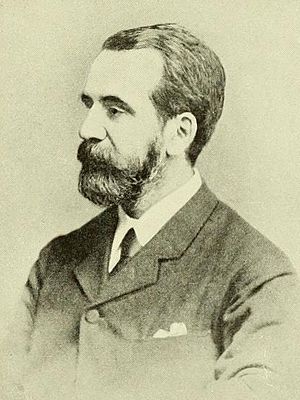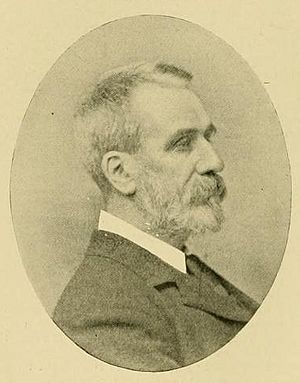George King (botanist) facts for kids
Sir George King (born April 12, 1840 – died February 12, 1909) was an important British botanist. He became the head of the Royal Botanic Garden, Calcutta in 1871. Later, in 1890, he was the first Director of the Botanical Survey of India. King was well-known for growing cinchona plants. He also created a system to deliver quinine medicine cheaply across India using the postal service.
Contents
Early Life and Education
King was born in Peterhead, Scotland. His parents, Robert King and Cecilia Anderson, both passed away from a serious lung illness (tuberculosis) when he was young. He became an orphan at age ten and was cared for by his uncle.
He went to Aberdeen Grammar School. Even though he was a good student, he had poor health and had to leave school in 1854. For a while, he worked in his uncle's printing business. But he was much more interested in nature, especially plants.
At eighteen, King decided to study medicine. He joined the University of Aberdeen in 1861. There, his teachers, like George Dickie, inspired him to learn more about plants.
In 1862, King became an assistant to Alexander Dickson. This made him interested in studying plants like ferns and mosses. He decided to join the Indian Medical Service in 1865. He traveled to India in March 1866.
Working in India
When King first arrived in India, he worked in hospitals. However, he often got sick. Doctors suggested he move to a drier climate. He was posted to different places across India, including Agra, Mathura, Guna, and Jodhpur.
During his free time, he studied the local plants. He even looked into plants that people could eat during times of food shortage. He also studied birds in Guna. While working in Dehra Dun, he discovered dishonest practices in the Forest Department. King worked hard to stop this corruption.
In 1871, King was chosen to become the Superintendent of the Royal Botanic Garden, Calcutta. The garden had been badly damaged by two big storms in 1864 and 1867. King worked to rebuild and improve it. He raised the ground level, created ponds, and built new paths. He also built a special fireproof building to store dried plant samples.
King changed the garden's design. Instead of grouping plants by their scientific family, he arranged them by region. This showed how different plants naturally grow together. He also started a scientific journal called Annals of the Royal Botanic Garden, Calcutta.
Growing Cinchona and Distributing Quinine
King was very involved in growing cinchona plants. These plants are important because they are used to make quinine, a medicine for malaria. He helped create a special position for a scientist to study quinine. This scientist found a way to extract natural chemicals from cinchona to make a medicine called Cinchona Febrifuge.
King later developed a brilliant system to get quinine to everyone. Starting in 1893, small packets of quinine were sold for a very small amount of money at village post offices across Bengal. This made the life-saving medicine available to many people.
Botanical Survey of India
In 1891, King became the first director of the Botanical Survey of India. This new organization connected botanists working in different parts of India. He also helped Sir Joseph Hooker with a major book about the plants of British India. King himself wrote important works on plants, including a book about the orchids of the eastern Himalayas.
In 1898, King left his position at the Calcutta Botanical Gardens.
Later Life and Legacy
King married Jane Anne Nicol in 1868. Sadly, Jane passed away in 1898 while they were traveling back to England. This was a very difficult time for King. In the years that followed, his health got worse. He lost an eye and became increasingly ill.
Sir George King passed away on February 12, 1909, in San Remo, Italy. He is buried there, but there is also a memorial for him and his wife in St Machar's Cathedral in Old Aberdeen, Scotland.
Honours and Awards
King received many awards for his important work.
- He was given an honorary degree (LL.D.) in 1884.
- He became a member of the Royal Society in 1887, which is a very high honour for scientists.
- The Royal Horticultural Society gave him the Victoria Medal of Honour in 1901 for his skills in garden design.
- He also received the Linnean Medal in 1901, another top award for botanists.
- For making quinine available cheaply, he was made an honorary member of the Pharmaceutical Society. Even Czar Alexander III gave him a special ring!
- He was made a Knight Commander of the Order of the Indian Empire in 1898.
A memorial was built for him in San Remo, where he often visited in winter. His work greatly helped both botany and public health in India.




